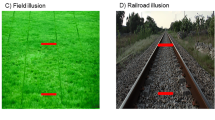Abstract
This paper deals with the problem of relating distance and scale by way of alternative models of perception taken from the history of science.The intuitive patterns of modern school children in evaluating the Solar System are then compared with those in the history of science. Immediate experience and intuition by children often contradict scientific understanding. The children in this study, for example, do not see the rays of the Sun as being parallel and ignore the curvature of the Earth. The authors argue that children's understanding of the rays of the Sun as not being parallel as well as their ignoring the curvature of the Earth is due to the limitation resulting from the students' `actual activity zone', and not to their insufficient knowledge. This study makes specific suggestions to broaden the scientifically based `actual activity zone' of students. We suggest that laboratory work based on historical experiments using elementary geometry – as, for example, the determination of the radiusof the Earth by Eratosthenes – promotes a scientific understanding of astronomicalmeasurements.
...The scale of space and time, which we customarily observe on Earth, and which is part of time, we become aware of the vastness of our universe, we are awed and humbled. But if astronomers spent all their time speculating about the immensity of the cosmos and the prodigious interval of time necessary for the evolution of the stars, their accomplishments would be few. The primary concerns of the astronomer when studying the cosmos are physical and mathematical interpretations of observations, predictions of future observations, and the development and refinement of his instruments for such interpretation and prediction. To help him in the conceptualization of his problem, astronomer may, consciously or unconsciously, visualize a small model representing the cosmic system under investigation. Using this method, we can arrive at an understanding of the relative dimensions of the system and an understanding of the time intervals involved.
Shklovskii I.S. and Carl Sagan (1966)Intelligent Life in the Universe
Similar content being viewed by others
References
Baxter, J.: 1989, 'Children's Understanding of Familiar Astronomical Events', International Journal of Science Education 11, 502-513.
Driver, R., Guesne, E. & Tiberghien, A.: 1985, Children's Ideas in Science, Open University Press, Milton Keynes, pp. 193-201.
Duit, R. & Treagust, D.F.: 1995, 'Students' Conceptions and Constructivist Teaching Approaches', in B.J. Fraser & H.J. Walberg (eds), Improving Science Education, The National Society for the Study of Education, Chicago, pp. 27-43.
Einstein, A.: 1956, 'Geometrie und Erfahrung', in Ideas and Opinions, Vol. 1, Preuss. Akad., N.Y., Sitzungsber, pp. 123-130.
Evans, J.: 1998, The History and Practice of Ancient Astronomy, Oxford University Press, N.Y., Oxford, pp. 20-22, 49–52, 63–73.
Feigenberg, J.: 2000, Wahrscheinlichkeitsprognostizierung im System der zielgerichteten Aktivitat, AFRA-Verlag, Butzbach-Griedel.
Feigenberg, J.: 1971, 'Probability Prognosis and Schizophrenia', Soviet Science Review 2(2), 119-123.
Glozzi, M.: 1965, Storia della Fisica, Vol. 2, Storia delle scienze, Torino, pp. 7-12.
Heath, T.L.: 1913, Aristarchus of Samos, Clarendon Press, Oxford.
Hoyle, F.: 1972, Astronomy, Crescent Books, New York, pp. 83-85, 88–91.
Kikas, E.: 1998, 'The Impact of Teaching on Students' Definitions and Explanations of Astronomical Phenomena', Learning and Instruction 5, 439-454.
Layser, D.: 1984, Constructing the Universe, Scientific American Library, New York, pp. 49-55.
Matthews, M.R.: 1994, Science Teaching. The Role of History and Philosophy of Science, Routledge, New York.
Moldwin, M.: 2000, 'How Big is our Sun?', The Physics Teacher 38, 115-116.
Monk, M. & Osborn, J.: 1997, 'Placing the History and Philosophy of Science on the Curriculum: A Model for the Development of Pedagogy', Science Education 81, 405-424.
Nussbaum, J. & Novick, S.: 1982, 'Alternative Frameworks, Conceptual Conflict and Accommodation: Toward a Principled Teaching Strategy', Instructional Science 11, 183-200.
Nussbaum, J.: 1985, 'The Earth as a Cosmic Body', in R. Driver, E. Guesne & A. Tiberghien (eds), Children's Ideas in Science, Open University Press, Milton Keynes, pp. 171-192.
Shklovskii, I.S. & Carl Sagan: 1966, Intelligent Life in the Universe, Dell Publishing Co., Paris.
Vosniadou, S.: 1994, 'Capturing and Modeling the Process of Conceptual Change', Learning and Instruction 4, 45-69.
Author information
Authors and Affiliations
Rights and permissions
About this article
Cite this article
Feigenberg, J., Lavrik, L.V. & Shunyakov, V. Space Scale: Models in the History of Science and Students Mental Models. Science & Education 11, 377–392 (2002). https://doi.org/10.1023/A:1016050526156
Issue Date:
DOI: https://doi.org/10.1023/A:1016050526156




